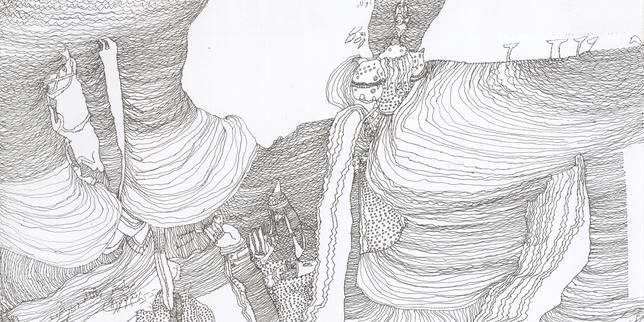Mythological Time
2016 - Film & Video (Film & Video)
12:44 minutes
Sun Xun
Sun Xun’s lushly illustrated, dynamic short film Mythological Time is a dreamy chronicle of rapacious industrial development, the mythical qualities of state propaganda, and the constancy of change, as experienced by an unnamed coal mining town. While it is not named in the film itself, the town at the center of Mythological Time is a re-imagined incarnation of Sun’s hometown of Fuxin, in the northern Chinese province of Liaoning. Sandwiched between North Korea and Inner Mongolia, Fuxin is a poor coal-mining region that used to contain one of China’s largest open-pit mines and has historically been the site of significant conflict, thanks to its rich mineral resources. In preparation to make the film, Sun, who is well known for his labor-intensive animation techniques and close attention to detail, spent over two weeks revisiting his hometown. Fuxin is cratered with sinkholes and blighted with cone-shaped spoil tips, much like the Fuxin depicted in Mythological Time. Unlike the real-life Fuxin, however, the Fuxin of the film is home to pheasants with human ears, bounding kirins, dragons that transform into trees, flying lumps of coal, and other chimerical beings; pangolins and fossils appear to be frozen in cubes of ice while old-fashioned cinemas project blank images onto nuclear power plants. The narrative of the film unfolds across two widescreen video images using a panoramic, scroll-like format, referencing the collapsed perspectives and flat narrative structure of Chinese landscape painting as mythological creatures both flee from and act as central characters within an alchemized, fantastical re-telling of a small town’s brutal path to modern industrialization. Borrowing frequently from the language of folklore as well as the visual strategies utilized by the Chinese Communist Party during Mao’s cult of personality, Sun’s work offers a palimpsest of official and oral histories to fill in the gaps carved out by state-administered amnesia. In Sun Xun’s world, time is a relentlessly transforming and transformable being, and the chronicle of human history is infinitely malleable. Human toil and industry exist in the realm of not just the mundane, but also the celestial.
Sun Xun creates videos and animation films from his meticulous, highly detailed, and often monochromatic, hand drawings executed in ink, oil, and crayon. Drawing on the ideas of thinkers like Karl Marx, Theodor Adorno, and Max Horkheimer, Sun investigates revolution, existence, mythologies of society, the notion of time, and the construction and narration of history. Often in a style of magical realism, Sun’s works are full of metaphors and indirect visual associations that beg to be deciphered.
Colors:
Related works featuring themes of: » Animals, » Animation, » China, » Collective History, » Chinese
» see more

© » KADIST
Chen Shaoxiong
2007After engaging primarily with video and photography for more than a decade, Chen turned to painting to explore the issue of urban change and memories—both personal and collective...

© » KADIST
Qiu Anxiong
2011A Portrait: Covering and Cleaning is an installation of six black-and-white video projections...
Other related works, blended automatically
» see more

© » KADIST
Chen Shaoxiong
2007After engaging primarily with video and photography for more than a decade, Chen turned to painting to explore the issue of urban change and memories—both personal and collective...
Related works sharing similar palette
» see more

© » LE MONDE
Sélection galerie : Farnood Esbati chez Christian Berst Cet article vous est offert Pour lire gratuitement cet article réservé aux abonnés, connectez-vous Se connecter Vous n'êtes pas inscrit sur Le Monde ? Inscrivez-vous gratuitement Article réservé aux abonnés Sans titre (vers 2020), de Farnood Esbati...

© » KADIST
Shilpa Gupta
2009In Untitled (Sword) , addressing histories of colonialism with abstraction, a large steel blade extends from the gallery wall...

© » KADIST
Kelly Sinnapah Mary
2021Notebook 10 , l ‘enfance de sanbras (The Childhood of Sanbras) series by Kelly Sinnapah Mary is a sequel to an earlier series by the artist titled Cahier d’un non retour au pays natal (2015)...
Related works from the » 2010's created around » Hangzhou, China
» see more

© » KADIST
Du Zhenjun
2010The Tower of Babel is an installation of large-format photographs that forces the audience to occupy a central position through its monumental scale...

© » KADIST
Qiu Anxiong
2011A Portrait: Covering and Cleaning is an installation of six black-and-white video projections...
Other works by: » Sun Xun
» see more
Related works found in the same semantic group
» see more

© » KADIST
Cheikh Ndiaye
2014Adjamé, Charbon reflects on both global environmental discourses and domestic impacts of the use and trade of coal...

© » KADIST
Nikita Kadan
2018East of Ukraine became a place of armed conflict with Russia-backed separatists, who proclaimed parts of (the) Donetsk and Lughansk oblast (administrative region in Ukrainian) to be ‘People’s republics’...








